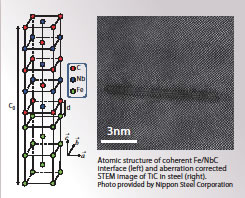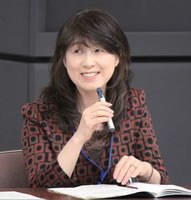“Interface and Structural Control”̶ CMSI Symposium on Industry- Government- Academia Cooperation
 Hideaki Sawada, presenting the results of simulation study. He works on large-scale ab initio calculation aiming to improve the steel strength based on the first principles. |
This CMSI Symposium on Industry- Government-Academia Cooperation was held jointly with the 2nd Computational Materials Research Initiative Symposium on December 6 and 7, 2011. The CMSI Symposium was held on the afternoon of the second day. The symposium began with case studies of the use of computational materials research at companies in accordance with the symposium’s theme “Interface and Structural Control.” Hideaki Sawada of Nippon Steel Corporation gave a presentation entitled “Structure and energy of steel precipitate interfaces.” He presented the results of a simulation study of precipitates, which are an important factor determining steel strength. The interface energy between the matrix phase and the precipitate determines how the size of the niobium carbide (NbC) and other precipitates produced in matrix phase steel will grow, and under what conditions. Tiny nanosize-level NbC has the same lattice position as the matrix layer of the steel (figure below), but as the precipitates mature, they come to be only partially aligned (semi-coherent interface), and this changes the interface energy between the matrix phase and the precipitate. A number of atoms on the order of several thousand to several tens of thousands must be taken into consideration in order to calculate this semi-coherent interface energy, and this was difficult to do using conventional firstprinciples calculation. Accordingly, Dr. Sawada used OpenMX, developed by Taisuke Ozaki of the Japan Advanced Institute of Science and Technology, to conduct parallel computing. This program uses the Order-N method, which employs a Krylov subspace, to make it possible to calculate polyatomic systems efficiently. The used computer was the TSUBAME2 at Tokyo Institute of Technology. As a result of the study, the energy and atomic positions of the semi-coherent interface were determined. In the future, Dr. Sawada plans to perform calculations that also take into account strain produced near the interface to predict the size of the precipitate that shifts from coherent to semi-coherent, in order to develop higher strength steel. Next, there were presentations by Kaoru Nakamura of the Central Research Institute of Electric Power Industry on a study entitled “Creep damage simulation in heatresistant steel interfaces,” and Hiroshi Kaido of Sumitomo Metal Industries, Ltd. on a study entitled “Evaluation of dislocation dynamics calculations and mechanical characteristics based on a phase-field model.” The content of these presentations gave a real sense that computational science is being incorporated into materials development. |
Two trends in industrygovernment-academia cooperation

These presentations were followed by a panel discussion on the theme of “Expectations for Industry-Government-Academia Cooperation.” In addition to the three presenters, the panelists wereMasanori Kohyama (National Institute of Advanced Industrial Science and Technology), Hiroshi Otani (Kyushu Institute of Technology) and Ying Chen (Tohoku University). Tooru Matsumiya of Nippon Steel Corporation served as moderator.
The panel discussion began with each of the panelists describing their experience with industry-governmentacademia cooperation. Then the main topic of discussion was posed to the panelists: what type of industry-governmentacademia cooperation would you like to see from the standpoint of computational materials science and industry promotion? “I have the impression that academics think that, for the industry side, the objective of industry-government-academia cooperation is to pursue the ultimate outputs, but I’d like universities to get the basics right,” said Dr. Sawada. “I want to convert those basics into concepts based on specific needs and have this lead to materials development.”
“If academics clearly determine the scope of application for software and so on, it would be helpful to people on the industry side who use that software,” said Mr. Nakamura, indicating that one trend in industrygovernment- academia cooperation was for academia to build the foundation and for companies to employ their capabilities for application.
In additional, Prof. Chen is thinking about another trend in industry-governmentacademia cooperation. “If issues that need resolution from an industry perspective and experimental data are provided to us, it would be very helpful for academics when we are considering where to put the focus of our research.”
Dr. Kohyama spoke about his hopes for the exchange of information. “What problems arise at manufacturing sites, and where are the issues that computational science can help resolve? If these were disclosed at seminars and the like and there were a venue for the frank exchange of information, it would enable calculations using fresh research topics.”
Seeking measures to link industry, government and academia |
|
|---|---|
 Panelist, Ying Chen. Specializes in first-principles calculation of properties of materials such as metals, magnets and nuclear fuels. |
So what kinds of specific things should be pursued? The need for personnel interchange and the introduction of internships has already been mentioned previously. “We had student interns to calculate the atomic states of elements in the periodic table using first-principles calculations, and determine through calculation why there is a tradeoff between strength and corrosion resistance, said Mr. Kaido. “Calculations that lead to useful properties are difficult to do at the university, so the students found this very rewarding.” Kazuhito Shida (Tohoku University) contributed to this report. |



